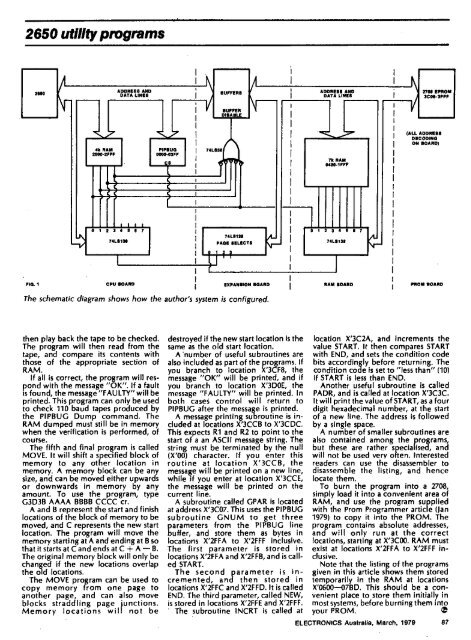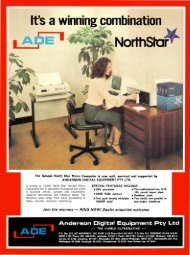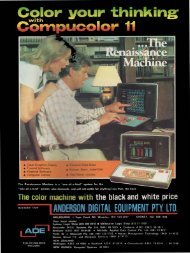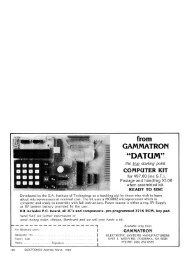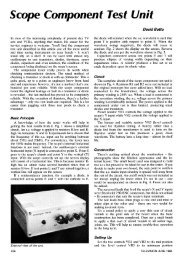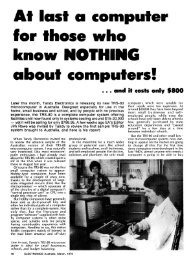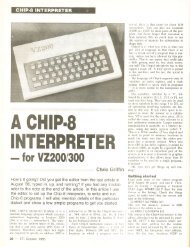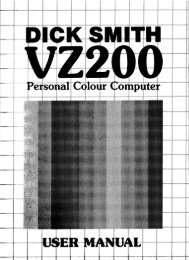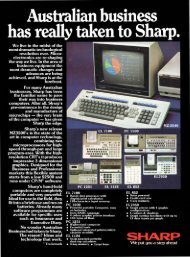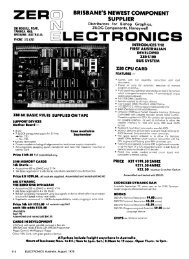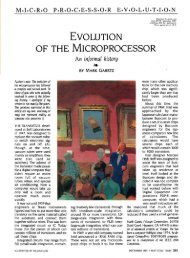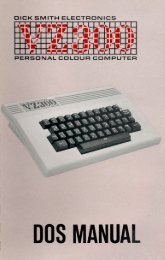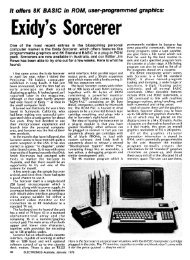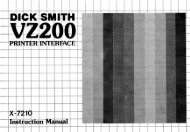The Signetics 2650 - The MESSUI Place
The Signetics 2650 - The MESSUI Place
The Signetics 2650 - The MESSUI Place
You also want an ePaper? Increase the reach of your titles
YUMPU automatically turns print PDFs into web optimized ePapers that Google loves.
<strong>2650</strong> utility programs<br />
ADDRESS AND<br />
DATA LINES<br />
DR RAM PIM.] 74LS30<br />
2000-2FFF 0000-03FF<br />
0 1 2 3 4 0 0 7<br />
F10.1 CPU BOARD<br />
S<br />
SUFFERS<br />
BUFFER<br />
DISABLE<br />
74LS13S<br />
PAGE SELECTS<br />
1 ?<br />
<strong>The</strong> schematic diagram shows how the author's system is configured.<br />
then play back the tape to be checked.<br />
<strong>The</strong> program will then read from the<br />
tape, and compare its contents with<br />
those of the appropriate section of<br />
RAM.<br />
If all is correct, the program will respond<br />
with the message "OK". If a fault<br />
is found, the message "FAULTY" will be<br />
printed. This program can only be used<br />
to check 110 baud tapes produced by<br />
the PIPBUG Dump command. <strong>The</strong><br />
RAM dumped must still be in memory<br />
when the verification is performed, of<br />
course.<br />
<strong>The</strong> fifth and final program is called<br />
MOVE. It will shift a specified block of<br />
memory to any other location in<br />
memory. A memory block can be any<br />
size, and can be moved either upwards<br />
or downwards in memory by any<br />
amount. To use the program, type<br />
G3D3B AAAA BBBB CCCC cr.<br />
A and B represent the start and finish<br />
locations of the block of memory to be<br />
moved, and C represents the new start<br />
location. <strong>The</strong> program will move the<br />
memory starting at A and ending at B so<br />
that it starts at C and ends at C -I- A — B.<br />
<strong>The</strong> original memory block will only be<br />
changed if the new locations overlap<br />
the old locations.<br />
<strong>The</strong> MOVE program can be used to<br />
copy memory from one page to<br />
another page, and can also move<br />
blocks straddling page Junctions.<br />
Memory locations will not be<br />
ADDRESS AND 2701 EPROM<br />
DATA LINES 3C011-1FFF<br />
71 RAM<br />
0400-1FFF<br />
(AU. ADDRESS<br />
DECODING<br />
ON BOARD)<br />
EXPANSION BOARD RAM BOARD PROM BOARD<br />
destroyed if the new start location is the<br />
same as the old start location.<br />
A 'number of useful subroutines are<br />
also included as part of the programs. If<br />
you branch to location X'3CF8, the<br />
message "OK" will be printed, and if<br />
you branch to location X'3D0E, the<br />
message "FAULTY" will be printed. In<br />
both cases control will return to<br />
PIPBUG after the message is printed.<br />
A message printing subroutine is included<br />
at locations X'3CCB to X'3CDC.<br />
This expects R1 and R2 to point to the<br />
start of a an ASCII message string. <strong>The</strong><br />
string must be terminated by the null<br />
(X'00) character. If you enter this<br />
routine at location X'3CCB, the<br />
message will be printed on a new line,<br />
while if you enter at location X'3CCE,<br />
the message will be printed on the<br />
current line.<br />
A subroutine called GPAR is located<br />
at address X'3C07. This uses the PIPBUG<br />
subroutine GNUM to get three<br />
parameters from the PIPBUG line<br />
buffer, and store them as bytes in<br />
locations X'2FFA to X'2FFF inclusive.<br />
<strong>The</strong> first parameter is stored in<br />
locations X'2FFA and X'2FFB, and is called<br />
START.<br />
<strong>The</strong> second parameter is incremented,<br />
and then stored in<br />
locations X'2FFC and X'2FFD. It is called<br />
END. <strong>The</strong> third parameter, called NEW,<br />
is stored in locations X'2FFE and X'2FFF.<br />
' <strong>The</strong> subroutine INCRT is called at<br />
location X'3C2A, and increments the<br />
value START. It then compares START<br />
with END, and sets the condition code<br />
bits accordingly before returning. <strong>The</strong><br />
condition code is set to "less than" (10)<br />
if START is less than END.<br />
Another useful subroutine is called<br />
PADR, and is called at location X'3C3C.<br />
It will print the value of START, as a four<br />
digit hexadecimal number, at the start<br />
of a new line. <strong>The</strong> address is followed<br />
by a single space.<br />
A number of smaller subroutines are<br />
also contained among the programs,<br />
but these are rather specialised, and<br />
will not be used very often. Interested<br />
readers can use the disassembler to<br />
disassemble the listing, and hence<br />
locate them.<br />
To burn the program into a 2708,<br />
simply load it into a convenient area of<br />
RAM, and use the program supplied<br />
with the Prom Programmer article (Jan<br />
1979) to copy it into the PROM. <strong>The</strong><br />
program contains absolute addresses,<br />
and will only run at the correct<br />
locations, starting at X'3C00. RAM must<br />
exist at locations X'2FFA to X'2FFF inclusive.<br />
Note that the listing of the programs<br />
given in this article shows them stored<br />
temporarily in the RAM at locations<br />
X'0600-07BD. This should be a convenient<br />
place to store them initially in<br />
most systems, before burning them into<br />
your PROM.<br />
ELECTRONICS Australia, March, 1979 87


